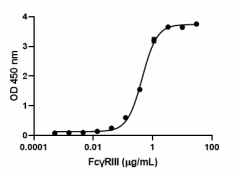- Regulatory Status
- RUO
- Other Names
- Fc-Gamma Receptor III-2 (CD16), Immunoglobulin G Fc Receptor III, Fc Fragment Of IgG, Low Affinity III, Receptor For, Low Affinity Immunoglobulin Gamma Receptor III-A Fc Fragment, Fc Fragment Of IgG Receptor IIIa, Fc-Gamma RIII-Alpha

-

When Ultra-LEAF™ purified mouse IgG2a, κ isotype ctrl antibody (Cat. No. 401507) is immobilized at 2.0 µg/mL, recombinant mouse FcγRIII binds in a dose-dependent manner. The EC50 range for this effect is 0.25 - 1.0 µg/mL. HRP anti-His Tag Antibody (Cat. No. 652503) was used to detect the binding. -

Stability Testing for Mouse FcγRIII. Recombinant mosue FcγRIII was aliquoted in PBS at 0.2 mg/mL. One aliquot was frozen and thawed four times (4x Freeze/Thaw), and compared to a control kept at 4°C (Control). The samples were tested in a binding assay with mosue IgG2a.
| Cat # | Size | Price | Quantity Check Availability | ||
|---|---|---|---|---|---|
| 790102 | 10 µg | $94.00 | |||
| 790104 | 25 µg | $194.00 | |||
Select size of product is eligible for a 40% discount! Promotion valid until December 31, 2024. Exclusions apply. To view full promotion terms and conditions or to contact your local BioLegend representative to receive a quote, visit our webpage.
FcγRIII, also known as CD16, is a low affinity IgG Fc receptor for a broad range of different isotypes. It primarily exists as two distinct forms: FcγRIIIA/CD16a and FcγRIIIB/CD16b, which are encoded by two nearly identical genes in humans. The expression of the two isoforms is tissue-specific. FcγRIIIA is a 50-65 kD type I transmembrane protein that is expressed on the surface of NK cells, activated monocytes, macrophages, and placental trophoblasts in humans. FcγRIIIB is a 48 kD GPI-anchored protein. Its extracellular domain is over 95% homologous to that of FcγRIIIA, and it is expressed specifically on neutrophils. FcγRIIIA can bind aggregated IgG or IgG-antigen complex which functions in NK cell activation, phagocytosis, and antibody-dependent cell-mediated cytotoxicity (ADCC). Several studies indicated that the post-translational modifications of FcγRIIIA or IgG regulate FcγRIIIA-mediated functions. The glycosylation of FcγRIIIA is mandatory for high affinity binding to Fc. Additionally, lack of fucosylation of Fc glycans dramatically enhance ADCC by improving the binding of FcγRIIIA and IgG. It has been reported that the polymorphism (F176V) showed a greater binding capacity to IgG, leading to increasing antibody-dependent NK cell cytotoxicity and susceptibility to autoimmune diseases. The missense mutation (L66H) causes immunodeficiency 20 disease (IMD20). FcγRIIIA associates with γ and zeta chains of T-cell antigen receptor complex (CD3:TCR) and FcεRIγ on human NK cells, suggesting involvement of distinct signal-transducing function.
Product Details
- Source
- Mouse FcγRIII, amino acid Ala31-Thr215 (Accession # P08508.1), with a C-terminal 10x His, was expressed in CHO cells.
- Molecular Mass
- The 195 amino acid recombinant protein has a predicted molecular mass of approximately 22.5 kD. The DTT-reduced protein and the non-reduced proteins migrate at approximately 45 kD by SDS-PAGE. The predicted N-terminal amino acid is Gln.
- Purity
- >95%, as determined by Coomassie stained SDS-PAGE
- Formulation
- 0.22 µm filtered protein solution is in PBS, pH7.2
- Endotoxin Level
- Less than 0.1 EU per µg protein as determined by the LAL method.
- Concentration
- 10 and 25 µg sizes are bottled at 200 µg/mL. 100 µg size and larger sizes are lot-specific and bottled at the concentration indicated on the vial. To obtain lot-specific concentration and expiration, please enter the lot number in our Certificate of Analysis online tool.
- Storage & Handling
- Unopened vial can be stored between 2°C and 8°C for up to 2 weeks, at -20°C for up to six months, or at -70°C or colder until the expiration date. For maximum results, quick spin vial prior to opening. The protein can be aliquoted and stored at -20°C or colder. Stock solutions can also be prepared at 50 - 100 µg/mL in appropriate sterile buffer, carrier protein such as 0.2 - 1% BSA or HSA can be added when preparing the stock solution. Aliquots can be stored between 2°C and 8°C for up to one week and stored at -20°C or colder for up to 3 months. Avoid repeated freeze/thaw cycles.
- Activity
- When Ultra-LEAF™ purified mouse IgG2a, κ isotype ctrl antibody (Cat. No. 401507) is immobilized at 2.0 µg/mL, recombinant mouse FcγRIII binds in a dose-dependent manner. The EC50 range for this effect is 0.25 - 1.0 µg/mL. HRP anti-His Tag antibody (Cat. No. 652503) was used to detect the binding.
- Application
-
Bioassay
- Application Notes
-
BioLegend carrier-free recombinant proteins provided in liquid format are shipped on blue ice. Our comparison testing data indicates that when handled and stored as recommended, the liquid format has equal or better stability and shelf-life compared to commercially available lyophilized proteins after reconstitution. Our liquid proteins are verified in-house to maintain activity after shipping on blue ice and are backed by our 100% satisfaction guarantee. If you have any concerns, contact us at tech@biolegend.com.
- Product Citations
-
Antigen Details
- Structure
- Immunoglobulin family
- Distribution
-
NK cells, activated monocytes, macrophages, neutrophils, subpopulation of T cells, immature thymocytes
- Function
- Low affinity IgG Fc receptor, phagocytosis, ADCC
- Interaction
- FcγR subunit
- Ligand/Receptor
- Aggregated IgG, IgG-antigen complex
- Bioactivity
- Measured by its ability to bind mouse IgG2a
- Antigen References
-
- Bruhns P. 2012. Blood. 119 5640.
- Hirano M, et al. 2007. Nat Immunol. 8:762.
- Takai T. 2002. Nat Rev Immunol. 2:580.
- Jakus Z, et al. 2008. J Immunol. 180:618.
- Nimmerjahn F and Ravetch JV. 2005. Science. 310:1510.
- Hazenbos WL, et al. 1996. Immunity. 5:181-8.
- Hazenbos WL, et al. 1998. J Immunol. 161:3026.
- Watanabe N, et al. 1999. Blood. 94:3855.
- Gene ID
- 14131 View all products for this Gene ID
- UniProt
- View information about FcgammaRIII on UniProt.org
